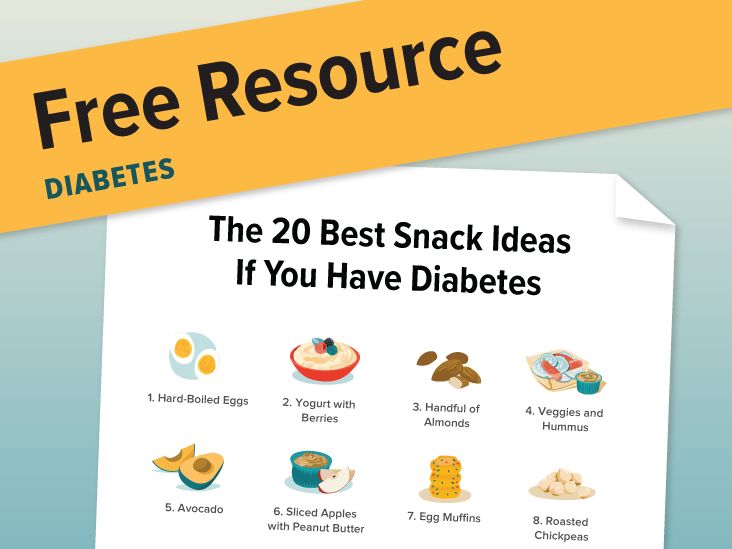
Understanding diabetes
Diabetes affects how your body processes glucose, which is a type of sugar. Glucose is important for your overall health. It serves as a source of energy for your brain, muscles, and other tissue cells. Without the right amount of glucose, your body has trouble functioning properly.
Two types of diabetes are type 1 and type 2 diabetes.
Type 1 diabetes
Five percent of people with diabetes have type 1 diabetes. If you have type 1 diabetes, your body can’t produce insulin. With proper treatment and lifestyle choices, you can still lead a healthy life.
Doctors usually diagnose type 1 diabetes in people who are younger than 40. The majority of people who are diagnosed with type 1 diabetes are children and young adults.
Type 2 diabetes
Type 2 diabetes is more common than type 1 diabetes. Your risk of developing it increases as you age, especially after age 45.
If you have type 2 diabetes, your body is insulin resistant. This means it doesn’t use insulin efficiently. Over time, your body can’t produce enough insulin to maintain consistent blood glucose levels. A number of factors can contribute to type 2 diabetes, including:
- genetics
- poor lifestyle habits
- excess weight
- high blood pressure
Diabetes affects men and women in different ways. Women with diabetes are at higher risk of:
- heart disease, which is the most common complication of diabetes
- blindness
- depression
If you’re diagnosed with diabetes, you can take steps to manage your blood sugar and lower your risk of complications. This can include eating a well-balanced diet, exercising regularly, and following your doctor’s prescribed treatment plan.
What are the symptoms?
The symptoms typically develop more slowly in type 2 diabetes than type 1 diabetes. Watch out for the following symptoms:
- fatigue
- extreme thirst
- increased urination
- blurred vision
- weight loss for no apparent reason
- tingling in your hands or feet
- tender gums
- slow-healing cuts and sores
The symptoms of diabetes vary. You may experience some or all of these symptoms. If you notice any of them, contact your doctor. They may be symptoms of diabetes or other medical issues.
It’s also possible to have diabetes with no obvious symptoms. That’s why it’s important to follow your doctor’s recommendations for routine blood glucose screening. Ask your doctor if they should check your blood glucose level.

HEALTHLINE RESOURCE
Eating well for diabetes, simplified — in just 10 mins
Our free weekly micro-lessons can empower you with wisdom you need to make healthy changes for your diabetes. Short and easy to follow tips for the week ahead.
Enter your emailSIGN UP NOWalso sign up for our popular Type 2 Diabetes Newsletter
Your privacy is important to us
What causes diabetes?
If you have diabetes, your body doesn’t produce or use insulin properly. Insulin is a hormone that helps your body convert glucose into energy and store excess glucose in your liver. When your body doesn’t produce or use insulin the way it should, glucose builds up in your blood. Over time, high blood glucose levels can lead to serious health complications.
Risk factors for diabetes
You’re at increased risk of developing diabetes if you:
- are over the age of 40
- are overweight
- eat a poor diet
- don’t exercise enough
- smoke tobacco
- have high blood pressure
- have a family history of diabetes
- have a history of gestational diabetes, which puts women at a greater risk of developing diabetes after childbearing age
- experience viral infections often

HEALTHLINE NEWSLETTER
Enjoy a free diabetes-friendly snack list
Our printable list compiles our favorite nutritious snack ideas to help you manage your blood sugar levels. Join our Type 2 Diabetes newsletter for your free copy and expert guidance twice a week.
Enter your emailJOIN NOW
Your privacy is important to us
Diagnosing diabetes
You won’t know if you have diabetes until you get properly tested. Your doctor will probably use a fasting plasma glucose test to check you for signs of diabetes.
Before the test, your doctor will ask you to fast for eight hours. You can drink water, but you should avoid all food during this time. After you’ve fasted, a healthcare provider will take a sample of your blood to check your fasting blood glucose level. This is the level of glucose in your blood when there’s no food in your body. If your fasting blood sugar level is 126 milligrams per deciliter (mg/dL) or higher, your doctor will likely diagnose you with diabetes.
You may take a separate test afterward. If so, you’ll be asked to drink a sugary beverage and wait two hours. Don’t expect to move much during this time. Your doctor wants to see how your body reacts to sugar. Your doctor will periodically test your blood sugar levels over the course of two hours. At the end of two hours, they’ll take another sample of your blood and test it. If your blood sugar level is 200 mg/dL or higher after two hours, it’s likely your doctor will diagnose you with diabetes.
Treating diabetes
Your doctor may prescribe medication to help keep your blood glucose in the healthy range. For example, they may prescribe oral pills, insulin injections, or both.
You need to maintain a healthy lifestyle to manage your diabetes and lower your risk of complications. Exercise regularly and eat a well-balanced diet. Consider following meal plans and recipes made especially for people with diabetes. For example, the American Diabetes Association offers recipes to help make healthy eating easier and less stressful.
Learn About Diabetes
0 seconds of 0 secondsVolume 0%
Your video will continue in 2 seconds
1:09
10 Ways to Reduce Your Type 2 Diabetes Risk
0:55
Everything You Need to Know About Type 2 Diabetes
0:59
Types of Diabetes Medications
1:04
Does Diabetes Affect Women Differently?
1:01
The Best Type 2 Diabetes Diet
0:59
Type 2 Diabetes And Skin Health
0:58
What’s the Difference Between Type 1 and Type 2…
0:57
How Do You Know If You Have Diabetes?
1:13
What Can You Drink If You Have Diabetes?
0:56
Can You Eat Watermelon if You Have Diabetes?
1:11
The Best Snack Ideas If You Have Diabetes
1:00
Can Diabetes Make Your Feet Itchy?
1:05
Best Way to Eat Oatmeal If You Have Diabetes
0:55
Diabetic Peripheral Neuropathy: What To Expect
1:01
What Are the Best Milk Options for People with…
0:55
The Best Sugar Substitutes for People with…
0:56
Which Breads Are Safest for People with Diabetes?
0:52
Can Bitter Melon Help With Diabetes?
0:56
Can People with Diabetes Safely Consume Cherries?
0:55
Cinnamon: Benefits for Blood Sugar and Diabetes
0:51
Is it Safe to Eat Apples With Diabetes?
1:06
The 10 Best Breakfast Foods For People With…
1:09
10 Foods And Drinks To Avoid With Diabetes
0:53
Coconut Oil: Is it Safe to Eat if You Have…
1:08
Alcohol and Diabetes: 9 Beverage Choices
What is the outlook?
Diabetes isn’t curable, but you can take steps to manage your blood sugar and lower your risk of complications. For example, eating a well-balanced diet and exercising 30 minutes per day can help you control your blood glucose levels. It’s also important to follow your doctor’s prescribed medication plan.
Prevention
Women over the age of 40 can take preventive measures to keep their glucose levels in check. This includes to following:
- Eat breakfast. This can help you maintain steady blood glucose levels.
- Lower the amount of carbohydrates in your diet. This means cutting down on bread and starchy foods such as white potatoes.
- Add a rainbow of colors to your plate every day, including brightly colored fruits and vegetables, such as berries, dark, leafy greens, and orange vegetables. This will help you get an array of vitamins and nutrients.
- Incorporate ingredients from multiple food groups into every meal and snack. For example, instead of eating only an apple, pair it with a swipe of protein-rich peanut butter or a serving of reduced-fat cottage cheese.
- Avoid soda and fruit drinks. If you enjoy carbonated beverages, try mixing sparkling water with a squeeze of citrus juice or a few cubes of fresh fruit.
Almost everyone can benefit from these healthy eating tips, so you don’t need to cook separate meals for you and your family. You can enjoy delicious and nutritious meals together. Adopting lifestyle habits may help you prevent diabetes and lower your risk of complications if you have it. It’s never too late to develop healthier habits.

HEALTHLINE NEWSLETTER
Get our Diabetes newsletter
Twice a week you’ll get tips on eating wisely, news on breakthroughs, and more resources to help you stay on top of your diabetes.
Enter your emailJOIN NOWAlso sign up for our popular Heart Health newsletter
Your privacy is important to us
Last medically reviewed on April 11, 2016
How we reviewed this article:
Sources
History
Our experts continually monitor the health and wellness space, and we update our articles when new information becomes available.
Current Version
Aug 20, 2018
Written By
Jennifer Purdie
Edited By
Frank Crooks
Apr 11, 2016
Medically Reviewed By
Deborah Weatherspoon, Ph.D., MSN
Share this article

Medically reviewed by Deborah Weatherspoon, Ph.D., MSN — Written by Jennifer Purdie — Updated on August 20, 2018
HEALTHLINE NEWSLETTER
Enjoy a free diabetes-friendly snack list
Our printable list compiles our favorite nutritious snack ideas to help you manage your blood sugar levels. Join our Type 2 Diabetes newsletter for your free copy and expert guidance twice a week.
